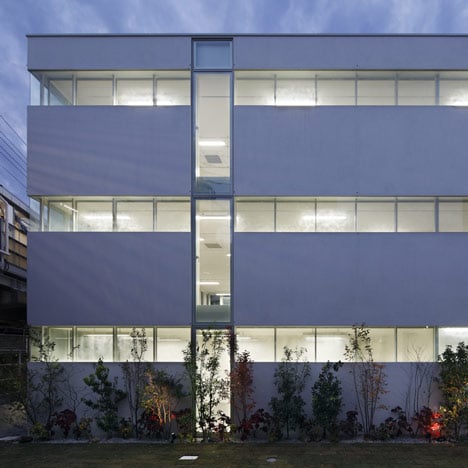Japanese architects Takeshi Hosaka have completed this office building in the Tokyo suburb of Yoyogi.
Located in a low rise, high density area, the Yoyogi Office Building is clad in white glass-fibre reinforced concrete panels.
Earthquake-resistant structures are hidden within a staircase and service core on the north side of the building, leaving each floor with an open plan to be divided up by tenants as necessary.
Strips of hand sand-blasted glazing round the top of each storey allow walls to be used for storage space, while eight full-height opening windows provide views over the surrounding garden and neighbourhood.
An apartment for the owner of the building is located on the top floor.
More about Takeshi Hosaka on Dezeen »
More Japanese architecture on Dezeen »
Photographs are by Koji Fujii/Nacasa & Partners
The following is from the architect:
Office Building in Yoyogi
This office building faces Minami-Shinjuku Station. In this district, a dense cluster of low-rise residences and mid-size buildings constitutes a traditional neighborhood, with skyscrapers standing a little distance away. To me, this site conjured up an image of a valley consisting of swarms of building masses.
I wanted to make the rental office building, which would be constructed on this site, blend in naturally with the surrounding environment. On its premises, the building has a square-shaped garden measuring 15 m on each side.
As for the floor planning, I realized an expansive construction with no visible earthquake-proof elements around the circumference by placing quake-resistant structures including a staircase, plumbing and other piping spaces to the north end. With one or two companies scheduled to occupy each floor, I prepared five different positions for partitions in order to accommodate tenants with varying sizes.
Taking into consideration the fact that many objects would be placed on the wall sides of small rental offices, I constructed the basic façade structure so that the walls would measure 180 mm above the floors, with the high-side structure being double-skin glass.
Furthermore, in consideration of the positional relationship with its perimeter and ventilation paths, the building provides eight vertical glass windows extending between the first and third floors.
The high-side glass was unevenly sandblasted through manual labor, thereby creating irregular texture with a cloudy/hazy touch. This generates a perspective that makes the neighboring buildings look a little more distant than they really are on the crowded premises, in addition to letting in the offices soft diffused light converted from direct sunlight. Moreover, through the uneven sandblasted glass, the weather and views outside appear slightly different from their usual selves.
This offers curious enjoyment indoors, loosely connecting the indoors and outdoors. Having the vertical glass windows extending from the first floor to third floor means that they stretch from the floor to the ceiling, thus enabling sufficient natural ventilation and an air-conditioner-free office environment in the middle period.
The white surface on the façade is a GRC panel. Overshadowed by a valley of buildings, the premises and their vicinity are dark. Therefore, I attempted to lighten up the surrounding by adding a white surface. In addition to trees passed down from the generation before last, the garden is planted with as many plants as possible to provide much greenery. Also, the ground outside is left unpaved as much as possible, with earthy surfaces reintroduced, in an attempt to pursue pleasant coexistence with soil and plants even in the urban area.
For small office buildings in metropolitan areas, it is a common practice to construct homogeneous and functional buildings that place priority on efficiency based on the economic principle. However, I believe that it is high time for us to think about building novel office structures as places where people can harmonize with environment based on a mixture of themes such as a new relationship between the outdoors and indoors, while still maintaining efficiency and functionality.
Through attempts that could be made on the premises such as setting aside a little space for plantation, securing earthy grounds, and applying uneven sandblast on glass surfaces, I tried to give birth to an office building with a varying degree of environmental latitude as a place where people stay instead of an artificially-controlled homogeneous construction.
Building Details
Architect: Takeshi Hosaka
Structural Engineers: Hirofumi Ohno
Photographer: Koji Fujii / Nacasa&Pertners Inc.
Client: Masanori Yoshida
Name: Yoyogi Office Building
Location: Yoyogi, Tokyo, Japan
Structure: Steel
Site: 398.88 m2
Building area: 209.13 m2
Floor area ratio: 635.69 m2
Building height: 9991mm
No. of floors: 3F
Building function: Office Building + Owner's House
Architect Details
(Name) Takeshi Hosaka
Takeshi Hosaka Architects
Planning data
Design: March 2008 – Feb. 2009
Planning start: March / 2008
Beginning of construction: April / 2010
Completion: December / 2010
See also:
.
| Hoto Fudo by Takeshi Hosaka Architects |
Inside Out by Takeshi Hosaka Architects | More Offices on Dezeen |

